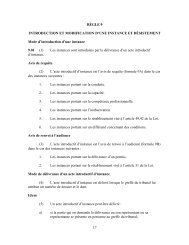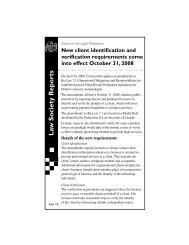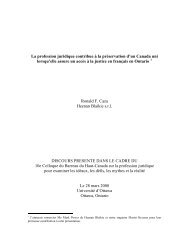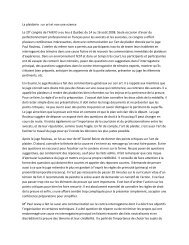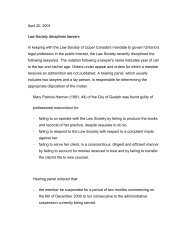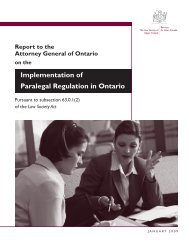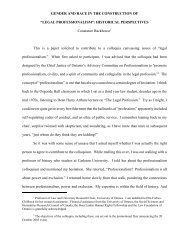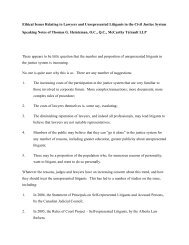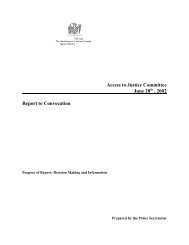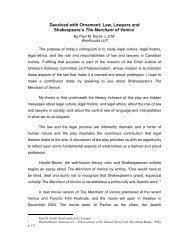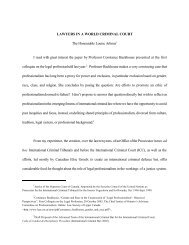respect for religious and spiritual beliefs a statement of principles of ...
respect for religious and spiritual beliefs a statement of principles of ...
respect for religious and spiritual beliefs a statement of principles of ...
You also want an ePaper? Increase the reach of your titles
YUMPU automatically turns print PDFs into web optimized ePapers that Google loves.
RESPECT FOR RELIGIOUS AND SPIRITUAL BELIEFSA STATEMENT OF PRINCIPLES OF THE LAW SOCIETYOF UPPER CANADA
THE LAW SOCIETY OF UPPER CANADARESPECT FOR RELIGIOUS AND SPIRITUAL BELIEFSA STATEMENT OF PRINCIPLES OF THE LAW SOCIETYOF UPPER CANADAMarch 10, 2005
TABLE OF CONTENTSINTRODUCTION.............................................................................................................. 3I – THE MEANING OF “RELIGION” AND “CREED”............................................... 6II – ONTARIO AND CANADA’S PROFILE................................................................. 8III – RELIGIOUSLY-MOTIVATED DISCRIMINATION AND HATE CRIME INONTARIO AND CANADA.............................................................................................. 9IV- LEGAL DEVELOPMENTS IN ONTARIO AND CANADA................................ 13LEGISLATION PROHIBITING HATRED AND DISCRIMINATION........................... 13CASE LAW DEVELOPMENT..................................................................................... 16V – THE INTERNATIONAL POSITION ..................................................................... 20VI – RESPECT FOR RELIGIOUS AND SPIRITUAL BELIEFS – STATEMENTOF PRINCIPLES............................................................................................................ 23CONCLUSION................................................................................................................ 252
should be celebrated. Instead, individuals <strong>and</strong> communities continue to bedisrupted by <strong>religious</strong> hatred <strong>and</strong> discrimination. 43. Hatred <strong>and</strong> discrimination on the basis <strong>of</strong> creed or religion are not acceptable.The Ontario Human Rights Code 5 , the Canadian Human Rights Act 6 , theCanadian Charter <strong>of</strong> Rights <strong>and</strong> Freedoms 7 (the Charter), the Criminal Code 8 , aswell as the Law Society <strong>of</strong> Upper Canada Rules <strong>of</strong> Pr<strong>of</strong>essional Conduct 9 containprovisions that recognize the value <strong>of</strong> <strong>religious</strong> or <strong>spiritual</strong> <strong>beliefs</strong> <strong>and</strong>/or prohibitdiscrimination <strong>and</strong> the wilful promotion <strong>of</strong> hatred on the basis <strong>of</strong> religion orcreed.4. The Law Society <strong>of</strong> Upper Canada recognizes the importance <strong>of</strong> promoting<strong>religious</strong> diversity <strong>and</strong> <strong>respect</strong> <strong>for</strong> <strong>religious</strong> <strong>beliefs</strong>. On April 22 nd , 2004,Convocation passed a motion that the Law Society’s Equity <strong>and</strong> AboriginalIssues Committee <strong>and</strong> the Law Society’s Government Relations Committeerecommend to Convocation <strong>for</strong> Convocation’s approval the role the Law Societyshould play <strong>and</strong> the positive steps it should take to discourage anti-Semitism <strong>and</strong>all <strong>for</strong>ms <strong>of</strong> hatred or discrimination based on religion in our pr<strong>of</strong>ession, oursociety <strong>and</strong> the world, <strong>and</strong> to promote <strong>religious</strong> <strong>respect</strong> in our pr<strong>of</strong>ession, oursociety <strong>and</strong> the world.5. In May 2004, a Working Group on Anti-Semitism <strong>and</strong> other Forms <strong>of</strong> Hatred <strong>and</strong>Discrimination Based on Religion (Working Group) was created with members<strong>of</strong> the Equity <strong>and</strong> Aboriginal Issues Committee/Comité sur l’équité et les affairesautochtones, the Government Relations Committee <strong>and</strong> other interested benchers.Joanne St. Lewis is Chair <strong>of</strong> the Working Group. The members <strong>of</strong> the WorkingGroup are: Andrea Alex<strong>and</strong>er, Gary Gottlieb, Thomas Heintzman <strong>and</strong> MarkS<strong>and</strong>ler.4 See infra paragraph 22 <strong>for</strong> a review <strong>of</strong> serious <strong>religious</strong>ly motivated hate incidents that were reported inOntario in 2004.5 Ontario Human Rights Code, R.S.O. 1990, c. H. 19.6 Canadian Human Rights Act, R.S. 1985, c. H-6.7 Canadian Charter <strong>of</strong> Rights <strong>and</strong> freedoms, Part I <strong>of</strong> the Constitution Act, 1982, being Schedule B to theCanada Act 1982 (U.K.), 1982, c. 11.8 Criminal Code, R.S.C. 1985, c. C-46.9 Rules <strong>of</strong> Pr<strong>of</strong>essional Conducl (Toronto: Law Society <strong>of</strong> Upper Canada, November 1, 2000).4
6. The Working Group decided that the Law Society should develop programs <strong>and</strong>initiatives to discourage anti-Semitism <strong>and</strong> all <strong>for</strong>ms <strong>of</strong> hatred or discriminationbased on religion, <strong>and</strong> to promote <strong>religious</strong> <strong>respect</strong>. Some <strong>of</strong> the initiativesproposed include creating a <strong>statement</strong> <strong>of</strong> <strong>principles</strong>; developing education <strong>and</strong>outreach programs; sponsoring <strong>and</strong> attending community events; recognizinglawyers who demonstrate a commitment to the issues; <strong>and</strong> publishingin<strong>for</strong>mation on a regular basis about the importance <strong>of</strong> promoting <strong>religious</strong> <strong>and</strong><strong>spiritual</strong> <strong>respect</strong> <strong>and</strong> discouraging hatred <strong>and</strong> discrimination based on religion.7. As part <strong>of</strong> the strategy to promote <strong>religious</strong> <strong>respect</strong> <strong>and</strong> discourage all <strong>for</strong>ms <strong>of</strong>hatred <strong>and</strong> discrimination based on religion, the Working Group developed aStatement <strong>of</strong> Principles <strong>for</strong> the legal pr<strong>of</strong>ession, included as Part VI <strong>of</strong> this report.The adoption <strong>of</strong> the Statement <strong>of</strong> Principles is well within the m<strong>and</strong>ate <strong>of</strong> theLaw Society “to govern the legal pr<strong>of</strong>ession in the public interest by […]upholding the independence, integrity <strong>and</strong> honour <strong>of</strong> the legal pr<strong>of</strong>ession <strong>for</strong> thepurpose <strong>of</strong> advancing the cause <strong>of</strong> justice <strong>and</strong> the rule <strong>of</strong> law”. A Statement <strong>of</strong>Principles <strong>for</strong> the legal pr<strong>of</strong>ession that promotes <strong>respect</strong> <strong>for</strong> <strong>religious</strong> belief <strong>and</strong>condemns hatred or discrimination based on religion not only advances the cause<strong>of</strong> justice <strong>and</strong> the rule <strong>of</strong> law, but also serves to educate the legal pr<strong>of</strong>ession inthe public interest.8. The Working Group also decided that a cross-section <strong>of</strong> the pr<strong>of</strong>ession should beinterviewed about the relationship between their faith/<strong>spiritual</strong> belief(s) <strong>and</strong>practices, the rule <strong>of</strong> law <strong>and</strong> legal practice. The exercise revealed thecommonality in the values <strong>and</strong> <strong>respect</strong> <strong>for</strong> human dignity <strong>of</strong> each religion. Thein<strong>for</strong>mation gathered through these interviews will be included in a separatereport entitled Dialogue with Lawyers: Religious <strong>and</strong> Spiritual Beliefs <strong>and</strong> thePractice <strong>of</strong> Law. The following individuals were interviewed: Kiran KaurBhinder (Sikh), Judith Holzman (Jewish), Douglas Elliott (Christian), Vinay Jain(Jain), John Borrows (Aboriginal), Amina Sherazee (Muslim), Anita Balakrishna(Hindu) <strong>and</strong> Eric Nguyen (Buddhist).5
9. This report is divided as follows:I- THE MEANING OF “RELIGION” AND “CREED”II- ONTARIO AND CANADA’S PROFILEIII- RELIGIOUSLY-MOTIVATED DISCRIMINATION ANDHATE CRIME IN ONTARIO AND CANADAIV- LEGAL DEVELOPMENTS IN ONTARIO AND CANADAV- THE INTERNATIONAL POSITIONVI- STATEMENT OF PRINCIPLESI – THE MEANING OF “RELIGION” AND “CREED”10. The term “creed” has <strong>of</strong>ten been used in Canadian legislation <strong>and</strong> case lawinterchangeably with “religion”. While the Ontario Human Rights Codepromotes equal treatment with <strong>respect</strong> to employment <strong>and</strong> the provision <strong>of</strong>services without discrimination because <strong>of</strong> creed 10 , the Charter 11 <strong>and</strong> theCanadian Human Rights Act 12 promote equality without discrimination because<strong>of</strong> religion.11. The Ontario Human Rights Commission <strong>and</strong> the Tribunal have interpreted creedbroadly to include religion. Creed means a pr<strong>of</strong>essed system <strong>and</strong> confession <strong>of</strong>faith, including both <strong>beliefs</strong> <strong>and</strong> observances or worship. A belief in a God orgods, or a single Supreme Being or deity is not a requisite. The existence <strong>of</strong><strong>religious</strong> <strong>beliefs</strong> <strong>and</strong> practices are both necessary <strong>and</strong> sufficient to the meaning <strong>of</strong>creed, if the <strong>beliefs</strong> <strong>and</strong> practices are sincerely held <strong>and</strong>/or observed.12. Although religion is not defined in the Ontario Human Rights Code, theCanadian Human Rights Act or the Charter, the Supreme Court <strong>of</strong> Canadaconsidered the definition <strong>of</strong> the term “religion” <strong>and</strong> <strong>religious</strong> practices inSyndicat Northcrest v. Amselem 13 . The appellants, all Orthodox Jews, set up10 Supra note 5.11 Supra note 7, section 15.12 Supra note 6.13 Syndicat Northcrest v. Anselem, [2004] S.C.J. No. 46 at para. 39 (QL).6
"succahs" on their balconies <strong>for</strong> the purposes <strong>of</strong> fulfilling the biblically m<strong>and</strong>atedobligation <strong>of</strong> dwelling in such small enclosed temporary huts during the annualnine-day Jewish <strong>religious</strong> festival <strong>of</strong> Succot. The respondent, the syndicate <strong>of</strong> coownershipSyndicat Northcrest, requested their removal, claiming the succahswere in violation <strong>of</strong> the by-laws as stated in the declaration <strong>of</strong> co-ownership,which prohibited decorations, alterations <strong>and</strong> constructions on the balconies. Therespondent proposed to allow the appellants to set up a communal succah in thegardens. The appellants expressed their dissatisfaction with the proposedaccommodation, explaining that a communal succah would not only causeextreme hardship with their <strong>religious</strong> observance, but would also be contrary totheir personal <strong>religious</strong> <strong>beliefs</strong>, which, they claimed, called <strong>for</strong> the setting up <strong>of</strong>their own succahs on their own balconies. The respondent filed an application <strong>for</strong>a permanent injunction prohibiting the appellants from setting up succahs <strong>and</strong>, ifnecessary, permitting their demolition.13. The Supreme Court <strong>of</strong> Canada defines religion <strong>and</strong> discusses the breadth <strong>of</strong>freedom <strong>of</strong> religion as follows:[Religion means] [f]reely <strong>and</strong> deeply held personal convictions or <strong>beliefs</strong>connected to an individual's <strong>spiritual</strong> faith <strong>and</strong> integrally linked to one'sself-definition <strong>and</strong> <strong>spiritual</strong> fulfilment, the practices <strong>of</strong> which allowindividuals to foster a connection with the divine or with the subject orobject <strong>of</strong> that <strong>spiritual</strong> faith […]Freedom <strong>of</strong> religion consists <strong>of</strong> the freedom to undertake practices <strong>and</strong>harbour <strong>beliefs</strong>, having a nexus with religion, in which an individualdemonstrates he or she sincerely believes or is sincerely undertaking inorder to connect with the divine or as a function <strong>of</strong> his or her <strong>spiritual</strong>faith, ir<strong>respect</strong>ive <strong>of</strong> whether a particular practice or belief is required by<strong>of</strong>ficial <strong>religious</strong> dogma or is in con<strong>for</strong>mity with the position <strong>of</strong> <strong>religious</strong><strong>of</strong>ficials. But, at the same time, this freedom encompasses objective aswell as personal notions <strong>of</strong> <strong>religious</strong> belief, “obligation”, precept,“comm<strong>and</strong>ment”, custom or ritual. Consequently, both obligatory as wellas voluntary expressions <strong>of</strong> faith should be protected under the Quebec(<strong>and</strong> the Canadian) Charter. It is the <strong>religious</strong> or <strong>spiritual</strong> essence <strong>of</strong> anaction, not any m<strong>and</strong>atory or perceived-as-m<strong>and</strong>atory nature <strong>of</strong> itsobservance that attracts protection. 1414 Ibid at paras. 46-47.7
II – ONTARIO AND CANADA’S PROFILE14. Canada is committed to human rights, mutual <strong>respect</strong> <strong>and</strong> the promotion <strong>of</strong>diversity <strong>and</strong> multiculturalism, including diversity <strong>of</strong> <strong>religious</strong> <strong>and</strong> <strong>spiritual</strong><strong>beliefs</strong>. Responses to the 2001 Canadian Census indicate that more than twentyfour million people in Canada, or eighty three percent <strong>of</strong> Canadians, identify asbeing <strong>of</strong> a <strong>religious</strong> or <strong>spiritual</strong> faith. In Ontario, nine <strong>and</strong> a half million people,or eighty four percent, identify as being <strong>of</strong> a <strong>religious</strong> or <strong>spiritual</strong> faith. TheCensus identifies nine majority faiths in Canada <strong>and</strong> in Ontario: Catholic,Protestant, Christian Orthodox, Christian not included elsewhere, Muslim,Jewish, Buddhist, Hindu <strong>and</strong> Sikh. In addition, approximately 65,000 people inCanada, <strong>and</strong> 19,000 people in Ontario, indicated their religion as being other thanthose already listed.15. Selected Religions, Ontario <strong>and</strong> Canada (2001 Census) 15CanadaOntarioTotal population 29,639,035 11,285,550Catholic 12,936,905 3,911,760Protestant 8,654,850 3,935,745Christian Orthodox 479,620 264,055Christian not includedelsewhere780,450 301,935Muslim 579,640 352,530Jewish 329,995 190,795Buddhist 300,345 128,320Hindu 297,200 217,555Sikh 278,410 104,785Eastern religions 37,550 17,780Other religions 63,975 18,985No <strong>religious</strong> affiliation 4,900,090 1,841,29015 Statistics Canada, “Selected religions, provinces <strong>and</strong> territories (2001 Census)”, online:http://www.statcan.ca/english/Pgdb/demo30b.htm.8
III – RELIGIOUSLY-MOTIVATED DISCRIMINATION AND HATE CRIME INONTARIO AND CANADA16. Notwithst<strong>and</strong>ing the diversity <strong>of</strong> <strong>religious</strong> <strong>beliefs</strong> in our country, there has been adisturbing rise in <strong>religious</strong>ly motivated discrimination <strong>and</strong> hate crime over thelast several years in Ontario <strong>and</strong> Canada. A 2001-2002 survey <strong>of</strong> twelve <strong>of</strong> themajor police <strong>for</strong>ces in Canada identified 928 hate crimes committed in thosejurisdictions during the period. 16 The results showed that 43% <strong>of</strong> the hate crimeswere motivated by religion. The survey confirmed that there was a spike in thenumber <strong>of</strong> hate crimes committed in the months immediately following theSeptember 11, 2001, terrorist attacks in the United States. There wereapproximately three times as many hate crimes recorded in Canada during thetwo months immediately after September 11, 2001 as there were during the sametwo-month period the year be<strong>for</strong>e. 17 Although the level <strong>of</strong> hate crime decreasedagain after its peak in the latter months <strong>of</strong> 2001, hate crimes motivated byreligion continued to be committed over the duration <strong>of</strong> the survey period. Twotrends identified by the survey were that Jews or their institutions were targetedin 25% <strong>of</strong> hate crimes, more <strong>of</strong>ten than any other group targeted in any type <strong>of</strong>hate crime. Jews were also the most frequent targets <strong>of</strong> hate crimes motivated byreligion, followed by Muslims.17. The League <strong>for</strong> Human Rights <strong>of</strong> B’nai Brith Canada recently released its 2004Audit <strong>of</strong> Anti-Semitic Incidents, which indicates that anti-Semitic incidents inCanada has risen by 46.7% from the previous year. 18 In total, 857 incidents were16 The Canadian Centre <strong>for</strong> Justice Statistics, Pilot Survey <strong>of</strong> Hate Crime (Results released June 1, 2004);summary available online: http://www.statcan.ca/Daily/English/040601/d040601a.htm. The Police Forcessurveyed were Calgary, Edmonton, Halton Regional, Montreal, Ottawa, Royal Canadian Mounted Police(excluding detachments from British Columbia), Regina, Sudbury, Toronto, Waterloo, Windsor, <strong>and</strong>Winnipeg. These services represent about 43% <strong>of</strong> the national volume <strong>of</strong> crimes measured by the Uni<strong>for</strong>mCrime Reporting Survey.17 Ibid.18 League <strong>for</strong> Human Rights <strong>of</strong> B’nai Brith Canada, Audit <strong>of</strong> Antisemitic Incidents, 2004 (published inMarch 2005). Available online: http://www.bnaibrith.ca/pdf/audit2004.pdf. The 2002 Audit indicates that459 anti-Semitic incidents were reported to B’nai Brith Canada’s League <strong>of</strong> Human Rights that year, anincrease <strong>of</strong> 60.48% from the 286 incidents reported in 2001. The 2003 Audit revealed that 584 anti-Semiticincidents were reported, representing an additional 27.2% increase over 2002. This was the highest number<strong>of</strong> incidents in the 20-year history <strong>of</strong> the Audit. The types <strong>of</strong> incidents reported each year ranged fromharassment to v<strong>and</strong>alism to severe violence.9
eported, the highest number in the twenty-two year history <strong>of</strong> the Audit. Since2000, the total number <strong>of</strong> incidents has increased more than three-fold. HaroldDavis, National President <strong>of</strong> B’nai Brith Canada stated in a press release “Thethreshold <strong>for</strong> what constitutes anti-Semitic activity continues its downward cycle,with open expressions <strong>of</strong> anti-Semitism being increasingly tolerated. A climate isbeing created where acts <strong>of</strong> anti-Semitism have simply become so commonplace,that the perpetrators <strong>of</strong> these crimes are <strong>of</strong>ten showed lenience, with their actsbrushed aside or labelled as mere ‘pranks’.” Frank Dimant, Executive Vice-President <strong>of</strong> B’nai Brith Canada, also states: “A disturbing trend has beendetected whereby incidents <strong>of</strong> anti-Semitism are becoming increasingly violent.Individuals are acting out their prejudices in less restrained fashion. Everyconcerted ef<strong>for</strong>t must be made to thwart this dangerous pattern, so that theseexpressions <strong>of</strong> hatred do not escalate. We’ve already seen the bombing <strong>of</strong> aJewish elementary school. Surely, this should be enough to sound the alarm.” 1918. Since September 2001, The Council on American-Islamic Relations Canada(CAIR-CAN) has documented hate activity against 19 Islamic institutions <strong>and</strong>mosques, including attempted arson, destruction <strong>and</strong> defacement <strong>of</strong> mosqueproperty, <strong>and</strong> graffiti. Six <strong>of</strong> those incidents have occurred in the last 12months. 2019. In addition to hate incidents, <strong>religious</strong> communities face a lack <strong>of</strong> acceptance <strong>of</strong>their <strong>religious</strong> practices. Those incidents occur at school or work. Where freedom<strong>of</strong> religion is litigated 21 , the students <strong>and</strong> families at the centre <strong>of</strong> thesecontroversies have faced anger <strong>and</strong> hostility from others.B’nai Brith Canada, 2002 Audit <strong>of</strong> Anti-Semitic Incidents, online:http://jewishcanada.ca/publications/audit2002/audit2002-00.html. B’nai Brith Canada, 2003 Audit <strong>of</strong> Anti-Semitic Incidents, online: www.bnaibrith.ca/publications/audit2003/audit2003-02.html.19 B’nai Brith press release posted March 15, 2005, available online at:http://www.bnaibrith.ca/prdisplay.php?id=886.20 On line in<strong>for</strong>mation from www.caircan.ca21 Examples <strong>of</strong> case law on point: Peel Board <strong>of</strong> Education v. Ontario Human Rights Commission (1991), 3O.R. (3d) 531 (Ont. Ct. Gen. Div. (Div. Ct.)); Multani(tuteur de) c. Commission scholaire Marguerite-Bourgeoys, [2004] J.Q. no. 1904 [Multani], leave to appeal to S.C.C. requested.10
20. In September 2003, at the invitation <strong>of</strong> the Canadian government, the UnitedNations Special Rapporteur on Contemporary Forms <strong>of</strong> Racism, RacialDiscrimination, Xenophobia <strong>and</strong> Related Intolerance visited Canada, <strong>and</strong>reported on his findings. In his report, the Special Rapporteur made note <strong>of</strong> theincrease in anti-Semitic activity in Canada in recent years, as well as thediscrimination <strong>and</strong> hate directed at Muslims in the wake <strong>of</strong> September 11, 2001.The Special Rapporteur made particular reference to the unique challenges facedby Muslim women, including discrimination related to wearing the hijab. Amongthe conclusions <strong>and</strong> recommendations <strong>of</strong> the Special Rapporteur was therecognition that the “resurgence <strong>of</strong> anti-Semitism <strong>and</strong> Islamophobia requires notonly vigilant attention <strong>and</strong> repression but also measures to promote dialoguebetween the communities concerned”. 2221. In 2004, numerous <strong>religious</strong>ly motivated hate incidents continue to be reported inCanada. Included in these incidents were the firebombing <strong>of</strong> the United TalmudTorah School library in Montreal in April, the upsetting <strong>of</strong> 24 headstones in aJewish Cemetery in Quebec City in June, <strong>and</strong> suspected arson related to a fire ina Sikh parochial school in Vancouver in July.22. The following are examples <strong>of</strong> some <strong>of</strong> the incidents that have taken place in2004, in Ontario:a. March 15, 2004 – Thirteen houses <strong>and</strong> vehicles were defaced withswastikas <strong>and</strong> anti-Semitic graffiti in Vaughan;b. March 21, 2004 – In a string <strong>of</strong> incidents in Toronto, windows werebroken <strong>and</strong> swastikas painted on the wall at the Pride <strong>of</strong> Israel Synagogue,swastikas were marked on street signs, homes <strong>and</strong> cars, a Jewish schoolwas damaged, <strong>and</strong> 27 headstones toppled at Bathurst Lawn Memorial ParkCemetery;22 Mr. Doudou Diene, Special Rapporteur on Contemporary Forms <strong>of</strong> Racism, Racial Discrimination,Xenophobia <strong>and</strong> Related Intolerance, Racism, Racial Discrimination, Xenophobia <strong>and</strong> all Forms <strong>of</strong>Discrimination, Mission to Canada, UN Doc. E/CN.4/2004/18/Add.2 (1 March 2004).11
c. March 25, 2004 – A fire was set at the Al-Mahdi Islamic Centre, a mosquein Pickering, <strong>and</strong> a Muslim business establishment was v<strong>and</strong>alized;d. March 26, 2004 – Four gravestones were toppled in the Beth DavidCemetery in Brant<strong>for</strong>d;e. March 28, 2004 – Fire fighters responding to a fire at a business inVaughan discovered swastikas painted on the front entrance;f. April 10, 2004 – A dozen headstones were toppled at the Beth JacobCemetery in Kitchener;g. June 12 & 13, 2004 – A Conservative Jewish c<strong>and</strong>idate had 9 <strong>of</strong> hiselection signs painted with swastikas in the Windsor West riding;h. June 20, 2004 – Anti-Semitic graffiti was discovered on an Ottawasynagogue;i. June 23, 2004 – In Toronto, Ryerson University’s multi-faith prayer roomwas defaced with anti-Muslim graffiti;j. June 27, 2004 – Anti-Semitic messages were painted on Unionvillestreets;k. August 2004 – Death threats were made against Muslim students in flyers<strong>and</strong> letters received by Ryerson University in Toronto;l. September 4, 2004 – A mosque in St. Catharines suffered damage to itsexterior wall when a car parked against the wall was set on fire <strong>and</strong> ignitedcardboard was stuffed into exterior vents <strong>of</strong> the building;m. October 14, 2004 – Death threats were received by the Arab StudentAssociation <strong>of</strong>fice <strong>and</strong> the Muslim Student Associations at RyersonUniversity in Toronto; <strong>and</strong>12
n. October 18, 2004 – A 21 year old man was arrested as he was posting hateliterature outside the Arab Student Association <strong>of</strong>fice at RyersonUniversity in Toronto.23. One <strong>of</strong> the most serious manifestations <strong>of</strong> anti-Semitism is Holocaust denial.Those who promote Holocaust denial assert that the Jewish Holocaust did nothappen. Although not all make the same claims, they promote the position, basedupon distorted, misleading or false in<strong>for</strong>mation, that there was no systematicattempt by Nazi Germany to exterminate European Jews. That manifestation <strong>of</strong>anti-Semitic hatred has attracted a tremendous amount <strong>of</strong> media attention <strong>and</strong> iswidely spread through the Internet. The cases <strong>of</strong> R. v. Keegstra 23 <strong>and</strong> R. v.Zundel 24 both dealt with hatred manifested by Holocaust denial.IV- LEGAL DEVELOPMENTS IN ONTARIO AND CANADALegislation Prohibiting Hatred <strong>and</strong> Discrimination24. When addressing incidents <strong>of</strong> <strong>religious</strong>ly motivated incidents, federal <strong>and</strong>provincial legislation prohibit either hatred or discrimination on the grounds <strong>of</strong>religion or creed. Provisions to this effect can be found in the Charter 25 , federal<strong>and</strong> provincial human rights legislation 26 , the Law Society <strong>of</strong> Upper CanadaRules <strong>of</strong> Pr<strong>of</strong>essional Conduct 27 , as well as the Criminal Code 28 .25. Section 2(a) <strong>of</strong> the Charter 29 guarantees freedom <strong>of</strong> conscience <strong>and</strong> religion.Section 15 further guarantees “every individual is equal be<strong>for</strong>e <strong>and</strong> under the law<strong>and</strong> has the right to the equal protection <strong>and</strong> equal benefit <strong>of</strong> the law without23 [1990] 3 S.C.R. 697 [Keegstra].24 [1992] 2 S.C.R. 731 [Zundel].25 Supra, note 7.26 Such as the Ontario Human Rights Code, supra note 5 <strong>and</strong> the Canadian Human Rights Act, supra note6.27 Supra note 9.28 Supra note 8.29 Supra note 7.13
discrimination <strong>and</strong>, in particular, without discrimination based on […] religion[…]” 3026. Other sections <strong>of</strong> the Charter also recognize the value <strong>of</strong> <strong>religious</strong> or <strong>spiritual</strong>faiths. For example, sections 25 <strong>and</strong> 35 guarantee Aboriginal rights <strong>and</strong> freedoms<strong>and</strong> section 27 recognizes that the Charter shall be interpreted in a mannerconsistent with the preservation <strong>and</strong> enhancement <strong>of</strong> the multicultural heritage <strong>of</strong>Canadians. Section 28 <strong>of</strong> the Charter guarantees Charter rights equally to men<strong>and</strong> women. There<strong>for</strong>e, the Charter recognizes that <strong>religious</strong> rights <strong>and</strong> practicesare guaranteed equally to men <strong>and</strong> women.27. Provincial human rights codes <strong>and</strong> the Canadian Human Rights Act also promotethe right to equality based on creed or <strong>religious</strong> <strong>beliefs</strong>. The Ontario HumanRights Code provides that every person has the right to equal treatment with<strong>respect</strong> to services, goods, facilities, accommodation (housing), employment, theright to enter into contracts, <strong>and</strong> membership in vocational associations withoutdiscrimination because <strong>of</strong> creed. 3128. The Canadian Human Rights Act prohibits discrimination on the ground <strong>of</strong>religion in relation to goods, services, facilities, accommodations, employment<strong>and</strong> employee organizations in a manner similar to the Ontario Human RightsCode. 32 The Canadian Human Rights Act also contains anti-hate provisions.Under the Act, it is discriminatory to publish or display any notice, sign, symbol,emblem or other representation that expresses or implies discrimination or anintention to discriminate, or incites or is calculated to incite others todiscriminate, if the discriminatory practice expressed or implied, if engaged in,would be discriminatory practice under other provisions <strong>of</strong> the Act. 33 It isdiscriminatory as well to communicate via telecommunication facilities anymatter that is likely to expose a person or persons to hatred or contempt by30 Ibid.31 Supra note 5, ss. 1-3, 5, 6.32 Supra note 6, ss. 3(2), 5, 7, 9.33 Ibid., s. 12.14
eason <strong>of</strong> the fact that that person or those persons are identifiable on the basis <strong>of</strong>a prohibited ground <strong>of</strong> discrimination.29. The Criminal Code deals specifically with hate crimes <strong>and</strong> hate-motivated crimesin sections 318 to 320, 430(4.1) <strong>and</strong> 718.2(a)(i). 34 Sections 318 <strong>and</strong> 319 prohibitadvocating genocide <strong>and</strong> public incitement <strong>of</strong> hatred or wilful promotion <strong>of</strong>hatred against any group distinguished by colour, race, religion, ethnic origin orsexual orientation. Chief Justice Dickson, in Keegstra, discusses the valuespromoted by the legislation:In my opinion, it would be impossible to deny that Parliament's objectivein enacting s. 319(2) is <strong>of</strong> the utmost importance. Parliament hasrecognized the substantial harm that can flow from hate propag<strong>and</strong>a, <strong>and</strong>in trying to prevent the pain suffered by target group members <strong>and</strong> toreduce racial, ethnic <strong>and</strong> <strong>religious</strong> tension in Canada has decided tosuppress the wilful promotion <strong>of</strong> hatred against identifiable groups. At thecore <strong>of</strong> freedom <strong>of</strong> expression lies the need to ensure that truth <strong>and</strong> thecommon good are attained, whether in scientific <strong>and</strong> artistic endeavours orin the process <strong>of</strong> determining the best course to take in our political affairs.[…] The message put <strong>for</strong>th by individuals who fall within the ambit <strong>of</strong> s.319(2) represents a most extreme opposition to the idea that members <strong>of</strong>identifiable groups should enjoy this aspect <strong>of</strong> the s. 2(b) benefit. Theextent to which the unhindered promotion <strong>of</strong> this message furthers freeexpression values must there<strong>for</strong>e be tempered ins<strong>of</strong>ar as it advocates withinordinate vitriol an intolerance <strong>and</strong> prejudice which view as execrable theprocess <strong>of</strong> individual self-development <strong>and</strong> human flourishing among allmembers <strong>of</strong> society. 3530. Sections 320 <strong>and</strong> 320.1 allow judges to authorize seizure <strong>of</strong> hate propag<strong>and</strong>a inhard copy or electronic <strong>for</strong>m. Section 430(4.1) was added to the Criminal Codein 2001 creating the <strong>of</strong>fence <strong>of</strong> mischief against places <strong>of</strong> <strong>religious</strong> worship or<strong>religious</strong> property “motivated by bias, prejudice or hate based on religion, race,colour, or national or ethnic origin”. Finally, a court is directed by section718.2(a)(i) <strong>of</strong> the Criminal Code to treat, as an aggravating feature on sentencing,evidence that any <strong>of</strong>fence was motivated, inter alia, by bias, prejudice or hatebased on religion as well as other enumerated grounds.34 Supra note 23.35 Supra note 23 at 762.15
31. The Law Society has also adopted rules <strong>of</strong> pr<strong>of</strong>essional conduct <strong>and</strong> modelpolicies that promote the <strong>respect</strong> <strong>for</strong> <strong>religious</strong> <strong>and</strong> <strong>spiritual</strong> <strong>beliefs</strong>. Rule 5.04 <strong>of</strong>the Rules <strong>of</strong> Pr<strong>of</strong>essional Conduct 36 specifies that a lawyer has a specialresponsibility “to <strong>respect</strong> the requirements <strong>of</strong> human rights laws in <strong>for</strong>ce inOntario <strong>and</strong>, specifically, to honour the obligation not to discriminate on thegrounds <strong>of</strong> […] creed […] with <strong>respect</strong> to pr<strong>of</strong>essional employment <strong>of</strong> otherlawyers, articled students, or any other person or in pr<strong>of</strong>essional dealings withother members <strong>of</strong> the pr<strong>of</strong>ession or any other person.” Rule 5.04 encompassesthe duty to accommodate <strong>religious</strong> or <strong>spiritual</strong> faiths <strong>and</strong> practices. Modelpolicies that prohibit harassment <strong>and</strong> discrimination on the ground <strong>of</strong> creed arealso available <strong>for</strong> the legal pr<strong>of</strong>ession. Such model policies <strong>and</strong> guidelinesinclude the Guide to Developing a Law Firm Policy Regarding AccommodationRequirements 37 , the Guide to Developing a Policy Regarding Flexible WorkArrangements 38 <strong>and</strong> Preventing <strong>and</strong> Responding to Workplace Harassment <strong>and</strong>Discrimination: A Guide to Developing a Policy <strong>for</strong> Law Firms 39 . The LawSociety also published an in<strong>for</strong>mation document entitled Accommodation <strong>of</strong>Creed <strong>and</strong> Religious Beliefs, Gender Related Accommodation <strong>and</strong>Accommodation <strong>for</strong> Persons with Disabilities: Legal Developments <strong>and</strong> BestPractices 40 , which outlines best-practices <strong>and</strong> legal developments in the area <strong>of</strong>accommodation <strong>and</strong> includes in<strong>for</strong>mation about accommodations <strong>of</strong> creed <strong>and</strong><strong>religious</strong> <strong>beliefs</strong> <strong>and</strong> practices.Case Law Development32. Tribunals, including the Supreme Court <strong>of</strong> Canada, have interpreted the termshate <strong>and</strong> discrimination. In Keegstra, the accused, an Alberta high school teacher36 Supra note 9.37 Guide to Developing a Law Firm Policy Regarding Accommodation Requirements (Toronto: LawSociety <strong>of</strong> Upper Canada, March 2001).38 Guide to Developing a Policy Regarding Workplace Equity in Law Firms (Toronto: Law Society <strong>of</strong>Upper Canada, updated March 2003).39 Preventing <strong>and</strong> Responding to Workplace Harassment <strong>and</strong> Discrimination: A Guide to Developing aPolicy <strong>for</strong> Law Firms (Toronto: Law Society <strong>of</strong> Upper Canada, March 2002).40 Accommodation <strong>of</strong> Creed <strong>and</strong> Religious Beliefs, Gender Related Accommodation <strong>and</strong> Accommodation<strong>for</strong> Persons with Disabilities: Legal Developments <strong>and</strong> Best Practices (Toronto: Law Society <strong>of</strong> UpperCanada, March 2001).16
whose teaching licence was revoked <strong>for</strong> communicating anti-Semitic <strong>statement</strong>sto his students, was charged under the Criminal Code with unlawfully promotinghatred against an identifiable group. Mr. Keegstra was convicted by a jury <strong>and</strong>sentenced to a $5,000.00 fine. The Alberta Court <strong>of</strong> Appeal overturned hisconviction on constitutional grounds, but the Supreme Court <strong>of</strong> Canada reversedthat decision. 41 The Supreme Court held that the Criminal Code provisions thatprohibit the dissemination <strong>of</strong> hate violated the guarantee <strong>of</strong> freedom <strong>of</strong>expression, but were saved under section 1 <strong>of</strong> the Charter. The case was remittedback to the Court <strong>of</strong> Appeal <strong>for</strong> decision on other issues, where a new trial wasordered. Mr. Keegstra was again found guilty <strong>and</strong> sentenced to a $3,000.00 fine.The Court <strong>of</strong> Appeal quashed his conviction on separate constitutional grounds,but the Supreme Court <strong>of</strong> Canada overturned that decision. 4233. Former Chief Justice Dickson held that hatred must be defined contextually. Hestated:Hatred is predicated on destruction, <strong>and</strong> hatred against identifiable groupsthere<strong>for</strong>e thrives on insensitivity, bigotry <strong>and</strong> destruction <strong>of</strong> both the targetgroup <strong>and</strong> <strong>of</strong> the values <strong>of</strong> our society. Hatred in this sense is a mostextreme emotion that belies reason; an emotion that, if exercised againstmembers <strong>of</strong> an identifiable group, implies that those individuals are to bedespised, scorned, denied <strong>respect</strong> <strong>and</strong> made subject to ill-treatment on thebasis <strong>of</strong> group affiliation. 4334. Other examples <strong>of</strong> incidents involving hatred include the case <strong>of</strong> Zundel in whichthe accused was charged with spreading false news after publishing a pamphletthat, inter alia, challenged the existence <strong>of</strong> the Holocaust. 44 Although Mr. Zundelwas found guilty <strong>and</strong> sentenced to nine months imprisonment, the Supreme Courtallowed the appeal <strong>and</strong> entered an acquittal after the majority held that therelevant Criminal Code provision was not justifiable under section 1 <strong>of</strong> theCharter.41 Keegstra, supra note 23.42 R. v. Keegstra, [1996] 1 S.C.R. 458, rev’g (1994), 157 A.R. 1 (C.A.).43 Supra note 23.44 Supra note 24.17
35. Although Mr. Zundel’s conviction was overturned by the Supreme Court <strong>of</strong>Canada, in 1996, complaints were filed with the Canadian Human RightsCommission alleging that Mr. Zundel was placing materials on the internet thatwere likely to expose people to hatred contrary to section 13 <strong>of</strong> the CanadianHuman Rights Act. Mr. Zundel posted a homepage on the Internet thatquestioned the existence <strong>of</strong> the Holocaust. In 2002, the Canadian Human RightsTribunal found that Mr. Zundel had engaged in discriminatory practice <strong>and</strong>ordered that he cease communicating messages that are likely to expose a personor group to hatred. 4536. In May 2003, Mr. Zundel was detained <strong>for</strong> being a threat to national security.The Federal Court ruled that his status within the white supremacist movement,his contacts <strong>and</strong> publications make him a danger to the security <strong>of</strong> Canada. 46 Mr.Zundel’s deportation order to Germany was carried out in March 2005. 4737. Racist or anti-Semitic hatred is <strong>of</strong>ten not confined to one single identifiablegroup. The case <strong>of</strong> Andrews <strong>and</strong> Smith v. The Queen 48 , dealt with theprosecution <strong>of</strong> two members <strong>of</strong> the Nationalist Party <strong>of</strong> Canada, a whitesupremacist political organization, <strong>for</strong> the wilful promotion <strong>of</strong> hatred directedagainst Black people, Jews, Pakistanis etc.38. Case law has also dealt with discrimination based on religion or creed.Discrimination is defined as follows:A distinction, whether intentional or not, but based on a protected ground,which has the effect <strong>of</strong> imposing burdens, obligations, or disadvantages onsuch individual or group not imposed upon others, or which withholds orlimits access to opportunities, benefits, <strong>and</strong> advantages available to othermembers <strong>of</strong> society. 4945 Citron v. Zundel, [2002] C.H.R.D. No. 1 (QL).46 Re Zundel, [2004] F.C.J. No. 60 (QL). In February 2005, the Federal Court determined that there werereasonable grounds to believe Mr. Zundel was inadmissible to Canada <strong>for</strong> being a security threat: ReZundel, [2005] F.C.J. No. 314 (QL).47 Kirk Makin “Zundel won’t fight deportation order” The Globe <strong>and</strong> Mail (26 February, 2005) A7.48 [1990] 3 S.C.R. 870.49 Law Society <strong>of</strong> British Columbia v. Andrews, [1989] 1 S.C.R. 143 at 174-175 [Andrews]. Discriminationincludes “direct discrimination” (where a practice or rule is adopted which on its face discriminates on aprotected ground); “adverse effect discrimination” (where a practice or rule is adopted which is on its face18
39. Some examples <strong>of</strong> incidents that involve discrimination <strong>and</strong> have been dealt withby tribunals relate to the observance <strong>of</strong> <strong>religious</strong> practices at work or at school.For example, in the employment context, the Human Rights Board <strong>of</strong> Inquiry inShapiro v. Peel (Regional Municipality) 50 ruled that an employee, who was anobservant member <strong>of</strong> the Jewish faith <strong>and</strong> had to use vacation time, lieu time orunpaid leave to celebrate Jewish holy days, was discriminated against. The Boardalso held that Ms. Shapiro’s proposal that she work overtime to make up <strong>for</strong> thetime she lost from work to celebrate Rosh Hashana was a reasonable one. Anemployer who requires a Jewish employee to use vacation or lieu time or unpaidleave in order to celebrate Jewish holy days discriminates under the Code. 5140. Case law has also addressed this issue in the context <strong>of</strong> education. Quebec courtsremain divided regarding the right <strong>of</strong> students to accommodations based on<strong>religious</strong> practices. In December 2001, a student was sent home from schoolbecause he wore a kirpan, a small ceremonial dagger worn by Sikhs. Althoughthe Québec Superior Court declared null <strong>and</strong> void the School Board’s ruling thatGurbaj Singh was not allowed to wear the kirpan, the Québec Court <strong>of</strong> Appealreversed the decision in March 2004. It held that the School Board’s decisioninfringed Mr. Singh’s full exercise <strong>of</strong> freedom <strong>of</strong> religion under the Charter, itwas properly restricted under s. 1 as the enjoyment <strong>of</strong> the freedom constituted athreat to the security <strong>of</strong> others. In April 2004, an application <strong>for</strong> leave to appealto the Supreme Court <strong>of</strong> Canada was filed. 5241. In 1994, a student was expelled from a public school in Québec <strong>for</strong> wearing thehijab, the Islamic headscarf. Later that same year another student was told thatshe would have to stop wearing the hijab or find a new school; she found a newneutral, <strong>and</strong> which will apply equally to everyone, but which has a discriminatory effect upon a prohibitedground on one person or group in that it imposes, because <strong>of</strong> some special characteristic <strong>of</strong> the person orgroup, obligations, penalties or restrictive conditions not imposed on other members); <strong>and</strong> “systemicdiscrimination” (practices or attitudes that have, whether by design or impact, the effect <strong>of</strong> limiting anindividual’s or a group’s right to the opportunities generally available because <strong>of</strong> attributed rather thanactual characteristics): See Andrews; Ontario Human Rights Commission <strong>and</strong> O'Malley v. Simpson-SearsLtd., [1985] 2 S.C.R. 536; Canadian National Railway Co. v. Canada (Canadian Human RightsCommission), [1987] 1 S.C.R. 1114.50 [1997] O.H.R.B.I.D. No. 15 (QL).51 Ibid.52 Multani, supra note 21.19
school. 53 Following these incidents, the Québec Commission des droits de lapersonne et des droits de la jeunesse produced a discussion paper in 1995 calledReligious Pluralism in Québec: a Social <strong>and</strong> Ethical Challenge. In the paper, theCommission regards the ban on the Islamic veil in public schools asdiscrimination based on religion <strong>and</strong> states that where the school’s rules interferewith the right to equality, the school has an obligation to accommodate <strong>and</strong> adaptthe rules to eliminate any discriminatory consequences. 54 Despite theCommission’s report, in 2003 another student was barred from a school inQuébec <strong>for</strong> wearing the hijab. The family <strong>of</strong> the girl filed a human rightscomplaint against the school, but later decided not to proceed with thecomplaint. 5542. The CRTC has recently been faced with investigating incidents <strong>of</strong> <strong>religious</strong>lymotivated hatred. During coverage <strong>of</strong> Palestinian leader Yasser Arafat’s funeralon November 12, 2004, three people on the Imus in the Morning radio show,simulcast on the all-news MSNBC, advocated dropping a bomb on Palestiniansto “kill ‘em all.” 56 The Canadian Radio-television <strong>and</strong> TelecommunicationsCommission (CRTC) is currently investigating over 20 complaints about theshow. 57V – THE INTERNATIONAL POSITION43. The harm <strong>of</strong> <strong>religious</strong> discrimination <strong>and</strong> the need to promote <strong>religious</strong> rights <strong>and</strong>freedoms has been recognized internationally. This position was <strong>for</strong>mally stated53 Kinda Jayoush “Students Strive to Wear Traditional Symbols in Class Decision Draws Wide Criticism:Muslim Council Ponders Legal Action” Montreal Gazette (24 September, 2003) A2.54 Commission des droits de la personne et des droits de la jeunesse by Pierre Bosset et al. (Québec:Commission des droits de la personne et des droits de la jeunesse, 1995) at 23, online:http://www.cdpdj.qc.ca/fr/publications/docs/hidjab.pdf.55 “Human rights complaint in hijab case dropped” CBC News (17 November, 2004), online:http://www.cbc.ca/story/canada/national/2004/11/16/hijab041116.html.56 Antoniz Zerbisias “Probe Here over Aired Arab Slurs: Arafat Mourners Derided on MSNBC” TheToronto Star (30 November, 2004), online: http://www.thestar.com; “Imus in the Morning” MSNBC (12November, 2004), online: Media Matters <strong>for</strong> America, http://www.mediamatters.org/items/200411190009.MSNBC later apologized to “anyone who was <strong>of</strong>fended by these remarks.”57 Zerbisias, ibid.20
in the UN Declaration on the Elimination <strong>of</strong> All Forms <strong>of</strong> Intolerance <strong>and</strong> <strong>of</strong>Discrimination Based on Religion or Belief (the “Declaration”) in 1981. 5844. Article 1 <strong>of</strong> the Declaration guarantees the right to thought, conscience <strong>and</strong>religion, including the right to choose one’s religion <strong>and</strong> freedom <strong>and</strong> to manifestone’s religion in private or in public, individually or in community with others.Articles 2 & 3 <strong>of</strong> the declaration guarantee the right to be free fromdiscrimination on the grounds <strong>of</strong> religion or belief, <strong>and</strong> condemn discriminationon these grounds as a violation <strong>of</strong> human rights <strong>and</strong> freedoms.45. Pursuant to the Declaration, the United Nations Commission on Human Rightsdecided, in Resolution 1986/20, to appoint a Special Rapporteur on Freedom <strong>of</strong>Religion or Belief. The Special Rapporteur’s m<strong>and</strong>ate is to examine incidents<strong>and</strong> governmental actions, which are inconsistent with the provisions <strong>of</strong> theDeclaration, <strong>and</strong> to recommend remedial measures, taking into account a genderperspective <strong>and</strong> the experience <strong>of</strong> various states.46. The Special Rapporteur’s report <strong>of</strong> January 15, 2003, documents violations <strong>of</strong> the<strong>principles</strong> <strong>of</strong> non-discrimination <strong>and</strong> <strong>respect</strong> perpetrated against people <strong>of</strong> variousfaiths in countries around the world. 59 The Special Rapporteur discussed the acts<strong>of</strong> hatred <strong>and</strong> discrimination, including verbal <strong>and</strong> physical assaults, committedagainst Muslims in the wake <strong>of</strong> September 11, 2001. Attacks on Jews <strong>and</strong>v<strong>and</strong>alism <strong>of</strong> synagogues were also noted. The Special Rapporteur’s analysisshowed an overall rise in hatred <strong>and</strong> discrimination against <strong>religious</strong> minorities<strong>and</strong> women <strong>and</strong> an increase in <strong>religious</strong> extremism affecting all religions.47. The Special Rapporteur noted that, in 2002, <strong>religious</strong> minorities faced threats totheir existence due to harassment (Christians in Myanmar), deportation(Adventists <strong>and</strong> Protestants in Azerbaijan), campaigns <strong>of</strong> repression (againstFalun Gong members), arrests (Protestants <strong>and</strong> Adventists in Turkmenistan),58 UN Declaration on the Elimination <strong>of</strong> All Forms <strong>of</strong> Intolerance <strong>and</strong> <strong>of</strong> Discrimination Based on Religionor Belief, GA Res. 36/55, UN GAOR, 36 th Sess., (1981).59 Mr. Abdelfattah Amor, Special Rapporteur on freedom <strong>of</strong> religion or belief, Civil <strong>and</strong> Political Rights,Including Religious Intolerance, UN ESC, 59 th Sess., UN Doc. E/CN.4/2003/66 (15 January 2003), online:www.unhchr.ch/html/menu2/7/b/religion/documents.htm.21
imprisonment <strong>and</strong> expulsion (Tibetan monks <strong>and</strong> nuns), <strong>and</strong> death sentences(Christians in China <strong>and</strong> members <strong>of</strong> the Ismaili community in Saudi Arabia).The Special Rapporteur described cases <strong>of</strong> <strong>religious</strong> hatred <strong>and</strong> discrimination bynon-state entities including violent attacks by Orthodox extremists on Jehovah’sWitnesses, Pentecostals <strong>and</strong> Catholics in Georgia; attacks on Muslims by Hinduextremists in India; attacks by Muslim extremists on <strong>religious</strong> minorities inBangladesh, Indonesia <strong>and</strong> Pakistan; violence against Coptic Christians in Egypt;<strong>and</strong> attacks on Catholic, Adventist, Methodist <strong>and</strong> Nazarene churches inYugoslavia. The Special Rapporteur also highlighted the discrimination that hadoccurred when <strong>religious</strong> minorities were subject to limitations on themanifestation <strong>of</strong> their <strong>religious</strong> identity or belief.48. As a result <strong>of</strong> recent incidents such as those recorded by the Special Rapporteur,the international community has come together at conferences on anti-Semitismorganized by the Organization <strong>for</strong> Security <strong>and</strong> Co-operation in Europe (OSCE)to promote <strong>religious</strong> <strong>respect</strong> <strong>and</strong> non-discrimination. The first conference tookplace in 2003 in Vienna 60 <strong>and</strong> was followed by a second conference in Berlin in2004 61 . Over four hundred participants from governments, internationalorganizations, <strong>and</strong> non-government organizations attended each conference,including delegations from Canada, the United States <strong>and</strong> a number <strong>of</strong> Europeancountries. Expert speakers presented in<strong>for</strong>mation <strong>and</strong> participants discussedstrategies <strong>for</strong> eliminating anti-Semitism. A number <strong>of</strong> recommendations cameout <strong>of</strong> the conferences including recommendations that States:a. Acknowledge that anti-Semitism is a human rights violation <strong>and</strong> condemn allmanifestations <strong>of</strong> anti-Semitism;b. Compile data <strong>and</strong> statistics relating to anti-Semitic incidents;c. Train law en<strong>for</strong>cement <strong>of</strong>ficers about hate crime;60 OSCE, Consolidated Summary <strong>of</strong> the OSCE Conference on Anti-Semitism, Vienna, 19 <strong>and</strong> 20 June 2003,PC.DEL/883/03 (18 July 2003).61 OSCE, Consolidated Summary <strong>of</strong> the OSCE Conference on Anti-Semitism, Berlin, 28 <strong>and</strong> 29 April 2004,PC.DEL/696/04/Rev.1 (27 July 2004). Online: http://www.osce.org/documents/cio/2004/07/3349_en.pdf.22
d. Ensure that legal systems foster a safe environment, free from anti-Semitism<strong>and</strong> discrimination;e. Implement hate crime legislation;f. Encourage in<strong>for</strong>mation exchanges on best practices <strong>and</strong> experiences in lawen<strong>for</strong>cement <strong>and</strong> education;g. Encourage political <strong>and</strong> civic leaders to speak out clearly <strong>and</strong> frequently againstdiscrimination;h. Encourage NGO ef<strong>for</strong>ts in the area <strong>of</strong> anti-discrimination;i. Implement anti-bias education in schools <strong>and</strong> elsewhere;j. Promote accurate remembrance <strong>and</strong>, as appropriate, education about theHolocaust;k. Promote inter-<strong>religious</strong> dialogue (possibly facilitated by a Code <strong>of</strong> Conduct);l. Avoid elevating certain religions over others; <strong>and</strong>m. Ensure that anti-Semitic materials are not disseminated in the media in print,electronic, or any other <strong>for</strong>m, while ensuring that faith-based communities areallowed equal access to media <strong>and</strong> are represented fairly in the media.VI – RESPECT FOR RELIGIOUS AND SPIRITUAL BELIEFS – STATEMENTOF PRINCIPLES49. The incidents <strong>of</strong> <strong>religious</strong>ly motivated discrimination <strong>and</strong> hatred outlined in thisreport <strong>and</strong> the Canadian <strong>and</strong> international condemnation <strong>of</strong> discrimination <strong>and</strong>hatred based on religion rein<strong>for</strong>ce the importance <strong>for</strong> the Law Society to adopt aStatement <strong>of</strong> Principles that recognizes <strong>religious</strong> diversity. There<strong>for</strong>e, the LawSociety adopts the following Statement <strong>of</strong> Principles.23
50. The Law Society <strong>of</strong> Upper Canada, recognizing that:a. Respect <strong>for</strong> <strong>religious</strong> diversity advances the cause <strong>of</strong> justice;b. The rule <strong>of</strong> law is enhanced when <strong>religious</strong>ly motivated discriminationor hatred is not tolerated;c. There continues to be a disturbing number <strong>of</strong> incidents <strong>of</strong> <strong>religious</strong>discrimination <strong>and</strong> <strong>religious</strong>ly motivated hate crimes in Ontario <strong>and</strong> inCanada, as well as in the world;d. The laws <strong>of</strong> Ontario <strong>and</strong> Canada guarantee freedom <strong>of</strong> conscience <strong>and</strong>religion, <strong>and</strong> prohibit discrimination <strong>and</strong> the wilful promotion <strong>of</strong> hatredon the basis <strong>of</strong> religion or creed;e. The international community has condemned <strong>religious</strong> discriminationas harmful <strong>and</strong> unacceptable, <strong>and</strong> has recommended that measures beundertaken to combat <strong>religious</strong> hatred <strong>and</strong> discrimination; <strong>and</strong>f. Although particular groups may be frequent targets <strong>of</strong> <strong>religious</strong>discrimination, <strong>religious</strong> hatred <strong>and</strong> discrimination is a problem <strong>of</strong>Canadian society as a whole;51. The Law Society <strong>of</strong> Upper Canada condemns in the strongest terms allmanifestations <strong>and</strong> <strong>for</strong>ms <strong>of</strong> hatred <strong>and</strong> discrimination based upon <strong>religious</strong><strong>and</strong> <strong>spiritual</strong> <strong>beliefs</strong>. Although current circumstances centre predominantlyon issues <strong>of</strong> anti-Semitism <strong>and</strong> Islamophobia, the Law Society condemns all<strong>for</strong>ms <strong>of</strong> <strong>religious</strong> intolerance directed at any group or community.52. The Law Society <strong>of</strong> Upper Canada undertakes to promote <strong>and</strong> support<strong>religious</strong> underst<strong>and</strong>ing <strong>and</strong> <strong>respect</strong> both inside <strong>and</strong> outside the legalpr<strong>of</strong>ession.24
CONCLUSION53. In accordance with our m<strong>and</strong>ate <strong>and</strong> the Bicentennial Report 62 , the Law Society<strong>of</strong> Upper Canada has undertaken a strategy to discourage all <strong>for</strong>ms <strong>of</strong> hatred <strong>and</strong>discrimination based on religion <strong>and</strong> to promote <strong>religious</strong> <strong>respect</strong> in ourpr<strong>of</strong>ession, society <strong>and</strong> the world.54. This report demonstrates that there are many <strong>religious</strong> practices in Ontario <strong>and</strong>Canada. Yet despite the existence <strong>of</strong> <strong>religious</strong> diversity in our country, there existmany incidents <strong>of</strong> <strong>religious</strong>ly motivated hate crimes <strong>and</strong> discrimination. Thelegislation <strong>and</strong> jurisprudence clearly indicate that <strong>religious</strong> dis<strong>respect</strong> is notacceptable. The Law Society has been proactive in creating this Statement <strong>of</strong>Principles to encourage <strong>religious</strong> <strong>respect</strong> in the legal pr<strong>of</strong>ession.55. The separate report entitled Dialogue with Lawyers: Religious <strong>and</strong> SpiritualBeliefs <strong>and</strong> the Practice <strong>of</strong> Law will present a dialogue with various members <strong>of</strong>the pr<strong>of</strong>ession. This is another aspect <strong>of</strong> the Law Society’s strategy aimed atdiscouraging <strong>religious</strong> hatred <strong>and</strong> discrimination. The Law Society anticipatesdoing other projects <strong>for</strong> this strategy, such as developing continuing legaleducation programs, public education programs <strong>and</strong> outreach programs withorganizations that promote <strong>religious</strong> <strong>respect</strong>.62 Supra note 1.25



